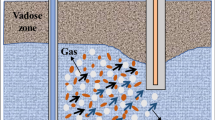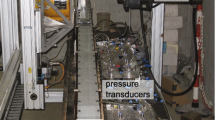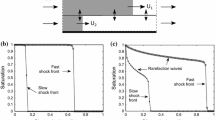Abstract
Fuel migration in a water flowing through a porous medium generally occurs parallel to porous strata, which may not be horizontal. In this case, gravity tends to cause vertical segregation of fluids, depending on their densities. This phenomenon can exert a strong effect on fuel migration. The gravitational force creates the buoyancy force which acts upon the fuel, and may be either parallel or anti-parallel to the water flow direction.
In this study, the above effects are investigated using the one-dimensional model of Pistineret al. We go beyond the latter investigation in describing the influence of the gravitational forces upon the movement of fuel saturation fronts in a vertical porous layer against and along the water flow direction.
It is found that when the directions of the buoyancy force and of the water flow are anti-parallel, fuel migrates in the direction of the buoyancy force, provided the latter is strong enough. However, in the case of a weak buoyancy force, the direction of migration of the fuel depends on its mass. Small fuel masses move mainly in the direction of the water flow. However, big fuel slugs possessing large masses will move mainly in the direction of the buoyancy force. Slugs, characterized by intermediate masses, have no preferable moving direction and are almost stagnant.
Similar content being viewed by others
References
Abramowitz, M. and Stegun, I. A., 1970,Handbook of Mathematical Functions, Dover, New York.
Bear, J., 1988,Dynamics of Fluids in Porous Media, Dover, New York.
Chen, Z.-X., 1988, Some invariant solutions to two-phase fluid displacement problem including capillary effect,Soc. Pet. Eng. J. 3, 691–700.
Marie, C. M., 1981,Multiphase Flow in Porous Media, Edition Technip, Paris.
Morrow, N. R. and Songkran, B., 1981, Effects of viscous and buoyancy forces on nonwetting phase trapping in porous media, in: Dinesh O. Shah (ed.),Surface Phenomena in Enhanced Oil Recovery, Plenum Press, New York, London, pp. 387–411.
Pirson, S. J., 1958,Oil Reservoir Engineering, McGraw-Hill, New York.
Pistiner, A., 1989, Fuel pollutant migration in groundwater, DSc Research thesis (in Hebrew), Technion, Haifa.
Pistiner, A., Shapiro, M., and Rubin, H., 1989a, Analysis of fuel pollutant migration in water flow through porous media,Int. J. Multiphase Flow. 15, 135–154.
Pistiner, A., Rubin, H., and Shapiro, M., 1989b, Migration of an immiscible contaminant in a water flow through a double porosity porous medium.Israel J. Technol. 25, 63–70.
Pistiner, A., Shapiro, M., and Rubin, H., 1990, Similarity solutions for immiscible phase migration in porous media: An analysis of free boundaries,Transport in Porous Media 5, 491–515.
Pistiner, A., Shapiro, M., and Rubin, H., 1991, A new solution for the nonlinear diffusion-convection equation,SIAM J. Appl. Math. 51, in press.
Ramakrishnan, T. S., Wilkinson, D., and Dias, M., 1988, Effect of capillary pressure on the approach to residual saturation,Transport in Porous Media 3, 51–79.
Wilkinson D., 1984, Percolation model of immiscible displacement in the presence of buoyancy forces,Phys. Rev. A 30, 520–531.
Author information
Authors and Affiliations
Rights and permissions
About this article
Cite this article
Pistiner, A., Shapiro, M. & Rubin, H. Gravitational migration of fuel in porous media. Transp Porous Med 9, 187–205 (1992). https://doi.org/10.1007/BF00611966
Received:
Issue Date:
DOI: https://doi.org/10.1007/BF00611966




